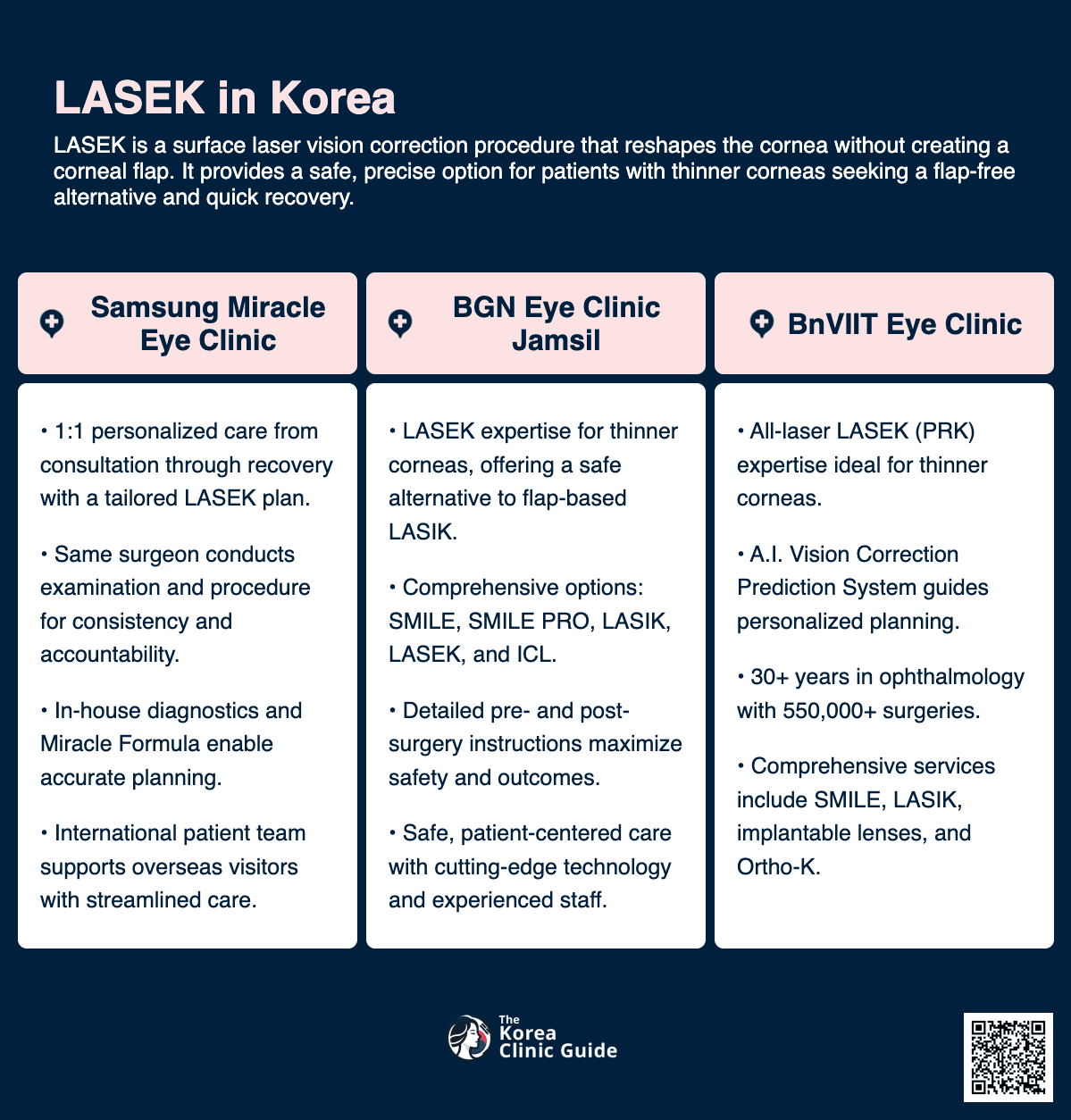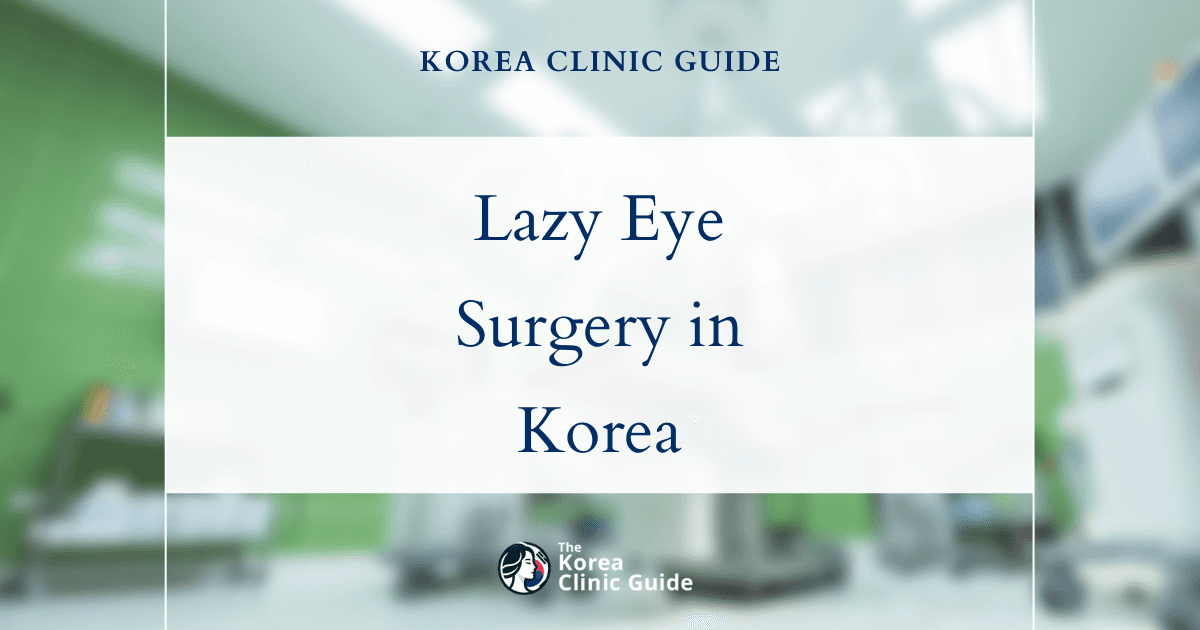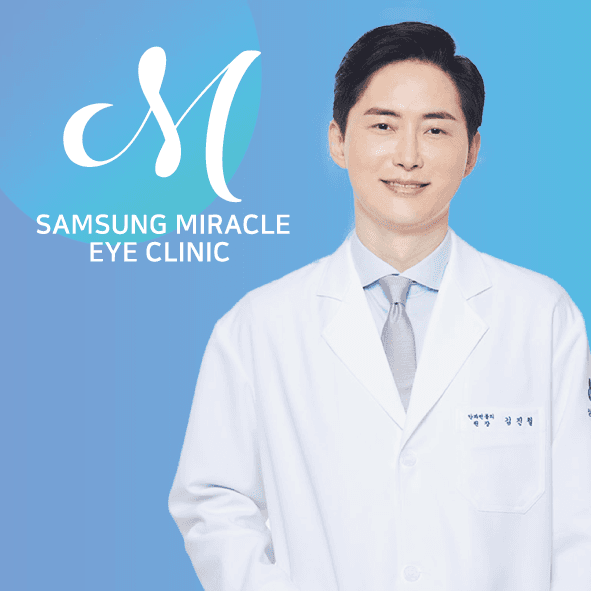Medical Tourism Blog
Blurred Vision (Refractive Error) Solutions: LASEK Procedure in Korea for Clearer Sight

Table of contents
- Understanding the Medical Basis of Blurred Vision (Refractive Error)
- The Science and Practice of the LASEK Procedure
- Best Clinics in Korea for Blurred Vision Refractive Error
- The Medical Tourist’s Journey to South Korea for LASEK
- Financial Analysis: Weighing the Cost and Value
- Patient Experiences: Outcomes, Risks, and Recovery
- Conclusion
- References
Considering treatment in Korea? Everything you need to know e.g. — how to avoid scams, visas, interpreters, recovery tips — in our Medical Tourism Master Guide. Plan with confidence in minutes, not weeks!
This guide is designed to help patients dealing with "blurred vision (refractive error)" from "corneal irregularities," focusing on the LASEK procedure in South Korea. We bring together medical expertise and real patient stories to clarify what causes these vision issues, how LASEK works, important things to know as a medical tourist, costs involved, and what to expect in terms of risks and results. The aim is to give patients clear, actionable information—turning a complex choice into a more manageable process.
One of the key takeaways is that people with conditions like severe astigmatism or Keratoconus are often better suited for LASEK than the commonly performed LASIK. South Korea is popular for this procedure because of its modern technology, highly trained surgeons, and lower cost compared to Western countries. While the term “LASEK” is sometimes used interchangeably with “PRK with Mitomycin C,” patients need to clarify the exact method each clinic uses. Recovery from LASEK is longer than LASIK, but most people report great results.
Understanding the Medical Basis of Blurred Vision (Refractive Error)
The Foundation: Refractive Errors and Corneal Function
Our eyes depend on a precise system to focus light on the retina, and the clear cornea at the front plays a major role. If the cornea isn't perfectly shaped, it causes refractive errors.
The four main types of refractive error are myopia (nearsightedness), hyperopia (farsightedness), presbyopia, and astigmatism. Myopia results from a long eyeball or curved cornea, making distant objects appear blurry. Hyperopia, caused by a short eyeball or flat cornea, makes close-up vision tough. Presbyopia comes with age, as the lens loses flexibility and near vision suffers. Astigmatism is a direct result of an irregular cornea—unlike a round baseball, the cornea is more like a football, bending light unevenly and leading to blurry or wavy vision at any distance.
A Deeper Dive into Keratoconus and Related Conditions
Patients with constant blur due to corneal irregularities might have Keratoconus, also called "KC," "KCN," or "conical cornea." This progressive disorder thins and bulges the cornea into a cone shape, worsening vision and sometimes leading to corneal transplantation. It typically starts in adolescence and gets worse into a person’s 30s, often affecting both eyes unequally.
While experts aren’t sure of the exact cause, a mix of genetic, environmental, and hormonal factors are suspected. Risks include family history, chronic eye allergies, and frequent eye rubbing. Other associations include asthma, eczema, Down syndrome, and Marfan syndrome. Keratoconus differs from other corneal thinning problems, such as Keratoglobus or Pellucid marginal degeneration.
From Symptoms to Diagnosis: The Patient's Journey
Early Keratoconus symptoms are subtle, often just mild blurriness that glasses can’t fix. Over time, people experience more symptoms like light sensitivity, glare, halos, headaches, and irritated eyes. A classic sign is monocular polyopia—seeing ghost images from a single point of light. Night vision and overall visual acuity decline.
Diagnosis involves a full eye exam and specialized tests. Corneal topography provides a detailed map of the cornea, while pachymetry measures corneal thickness. A slit-lamp exam checks outer corneal layers for issues. These results are essential for deciding if a patient is a good candidate for laser vision correction and, if so, which procedure is safest. Thin corneas or the presence of Keratoconus usually shift recommendations away from LASIK toward LASEK or PRK.
The Science and Practice of the LASEK Procedure
The Mechanism of LASEK
LASEK (Laser-Assisted Sub-Epithelial Keratectomy) is a type of refractive surgery where a laser reshapes the cornea’s surface to improve vision. It uses an ultraviolet excimer laser to carefully remove layers of corneal tissue, adjusting how the eye focuses light. The whole process usually takes less than half an hour for both eyes.
LASEK vs. LASIK and PRK: A Procedural Comparison
There are several laser eye surgery options, and it's important to know the differences if you have corneal irregularities.
- LASIK (Laser-Assisted In Situ Keratomileusis) involves creating a thin corneal flap, which is folded back so the underlying tissue can be reshaped, then repositioned for fast healing.
- LASEK and PRK (Photorefractive Keratectomy) are both "flap-free." They’re better choices for people with thin corneas or active lifestyles. In LASEK, alcohol is used to loosen the epithelium (outer layer), which is moved aside, then put back after the laser reshapes the cornea. In PRK, the epithelium is removed entirely and grows back naturally.
What’s often called LASEK today might be PRK with MMC (Mitomycin C), as using MMC has greatly reduced risks like corneal haze, which was a concern with older techniques. Anyone considering surgery should ask about the clinic's exact procedure and the use of Mitomycin C.
| Procedure | Corneal Flap Creation | Ideal Patient Profile | Post-Operative Pain | Recovery Time | Flap-Related Complications |
|---|---|---|---|---|---|
| LASIK | Yes (Laser or Blade) | Standard prescriptions, thicker corneas | Minimal | Rapid (hours to a day) | Possible |
| LASEK | No | Thin corneas, high myopia, contact sports | Moderate to Significant | Longer (days to weeks) | None |
| PRK | No | Thin corneas, high myopia, contact sports | Moderate to Significant | Longer (days to weeks) | None |
The Surgical Process: A Step-by-Step Walkthrough
LASEK is performed in a careful sequence. You’ll recline, get numbing drops, and have your eyelids gently held open. A mild alcohol solution loosens the epithelium, which is moved aside to reveal the cornea. You’ll be asked to focus on a light so the laser can reshape the cornea precisely. The epithelium is then repositioned, and a bandage contact lens is applied to protect it while it heals—this remains in place for a few days.
Best Clinics in Korea for Blurred Vision Refractive Error
Listed below are the best clinics in Korea for blurred vision refractive error:
| Clinic Name | Key Features | Special Techniques |
|---|---|---|
| Samsung Miracle Eye Clinic Website | 1:1 personalized care; same-day diagnostic and surgical system; ambidextrous surgeons; International Patient Team; comprehensive solutions for blurred vision from refractive errors | SMILE LASIK; LASIK/LASEK for myopia, hyperopia, and astigmatism; presbyopia and cataract treatment with advanced intraocular lenses; intraocular lens insertion for severe vision problems; re-calibration surgery for fine-tuning prior vision corrections; non-surgical Dream Lens (orthokeratology); dry eye treatments |
| Bright Eye Clinic Website | Comprehensive refractive surgery options tailored to your eyes: SMILE Pro with VisuMax 800; SMILE LASIK; LASIK; LASEK; Rigorous pre-surgery examinations; Advanced cataract care when blur is lens-related; Ongoing care to protect long-term vision; State-of-the-art equipment operated by experienced professionals; Convenient Gangnam location | SMILE Pro with VisuMax 800; SMILE LASIK; LASIK; LASEK; Lumera 700 cataract removal; premium IOL types |
| BGN Eye Clinic Jamsil Website | Premier eye care center in Korea dedicated to resolving blurred vision caused by refractive errors with cutting-edge solutions; full spectrum of vision correction procedures including SMILE and SMILE PRO for myopia and astigmatism; LASIK; LASEK; Implantable Collamer Lenses (ICL); cataract surgery with monofocal intraocular lenses; presbyopia surgery with multifocal intraocular lenses; individualized treatment planning; detailed pre- and post-surgery instructions; safety, comfort, and optimal outcomes | SMILE; SMILE PRO; LASIK; LASEK; ICL; monofocal IOLs; multifocal IOLs |
Samsung Miracle Eye Clinic
Samsung Miracle Eye Clinic, located at Gangnam Station, is a leading center for refractive error–related blurred vision in Korea, offering comprehensive eye care through highly professional medical experts and advanced technology. The clinic combines 1:1 personalized care, a same-day diagnostic and surgical system, and uniquely skilled ambidextrous surgeons to deliver precise, symmetrical outcomes with comfort and safety in mind. An experienced International Patient Team ensures a seamless experience for visitors from abroad, from consultation to recovery.
- 1:1 personalized care: Every patient receives a tailored consultation and customized surgical plan. The same doctor who conducts your eye examination will personally perform your surgery and oversee your entire recovery, ensuring consistency, accountability, and optimal results.
- One-Day System: With an advanced in-house diagnostic platform and a patented Miracle Formula for precise lens power calculation, both diagnosis and surgery can be completed on the same day—maximizing convenience without compromising accuracy.
- Ambidextrous surgeons: All surgeons operate with equal precision in both eyes, providing excellent symmetry and accuracy while minimizing contact with the nasal bridge for enhanced safety and comfort.
- International Patient Team: Dedicated coordinators deliver the same level of quality, comfort, and convenience for international patients, streamlining scheduling and care.
- Comprehensive solutions for blurred vision from refractive errors: SMILE LASIK for minimally invasive corneal reshaping; LASIK/LASEK for myopia, hyperopia, and astigmatism; presbyopia and cataract treatment with advanced intraocular lenses; intraocular lens insertion for severe vision problems; re-calibration surgery for fine-tuning prior vision corrections; non-surgical Dream Lens (orthokeratology) for daytime freedom from glasses or contacts; and dry eye treatments to optimize visual quality and comfort.
You can check out their website here: Samsung Miracle Eye Clinic Website
Bright Eye Clinic
Bright Eye Clinic in Gangnam is a premier destination for patients seeking fast, precise solutions to blurred vision caused by refractive errors, combining world-class expertise with cutting-edge technology to deliver individualized care that attracts patients from around the globe.
- Comprehensive refractive surgery options tailored to your eyes:
- SMILE Pro with VisuMax 800: minimally invasive, creates the lenticule in under 10 seconds for highly precise correction
- SMILE LASIK: small-incision approach for minimal discomfort and quick recovery
- LASIK: reshapes the cornea to treat myopia, hyperopia, and astigmatism
- LASEK: surface treatment ideal for patients with thin corneas
- Rigorous pre-surgery examinations to determine the safest, most effective procedure for your refractive error
- Advanced cataract care when blur is lens-related:
- Cataract removal using the Lumera 700 microscope for clarity and precision
- IOL implantation with a range of premium lens types tailored to individual visual needs
- Ongoing care to protect long-term vision:
- General eye health checkups to maintain ocular health and detect issues early
- State-of-the-art equipment operated by experienced professionals, ensuring high-quality care and consistently successful outcomes
- Convenient Gangnam location with a reputation that draws international patients seeking exceptional eye care
Find more about this clinic here: Bright Eye Clinic Website
BGN Eye Clinic Jamsil
BGN Eye Clinic Jamsil is a premier eye care center in Korea dedicated to resolving blurred vision caused by refractive errors with cutting-edge solutions. The clinic offers a full spectrum of vision correction procedures, including SMILE and SMILE PRO for minimally invasive myopia and astigmatism correction, LASIK to precisely reshape the cornea for myopia, hyperopia, and astigmatism, and LASEK as an option for patients with thinner corneas. For those unsuitable for corneal laser surgery or with higher prescriptions, Implantable Collamer Lenses (ICL) provide an internal lens solution that preserves the natural cornea while addressing significant myopia and astigmatism.
Beyond corneal and lens-based refractive treatments, the Jamsil clinic also provides cataract surgery with monofocal intraocular lenses to restore clear distance vision and presbyopia surgery with multifocal intraocular lenses to improve both near and distance focus. Every patient receives thorough evaluations, individualized treatment planning, and detailed pre- and post-surgery instructions designed to promote safety, comfort, and optimal outcomes. With a comprehensive range of options, BGN Eye Clinic Jamsil tailors care to each patient’s needs across myopia, hyperopia, astigmatism, and age-related vision changes.
Find more about this clinic here: BGN Eye Clinic Jamsil Website
The Medical Tourist’s Journey to South Korea for LASEK
South Korea as a Premier Destination

South Korea is a top spot for vision correction, with internationally accredited clinics and skilled surgeons, especially in Seoul’s Gangnam district. These clinics use advanced technology and often have English-speaking staff. The efficient Korean system allows many patients to complete pre-op exams and surgery in just a day or two. Medical tourism agencies, like Shin Medical, help international patients with translation, scheduling, and travel logistics, making the journey easier.
A Step-by-Step Guide to Getting LASEK in South Korea
Here’s what an international patient can expect:
- Pre-Trip Planning: Book your consultation, plan travel and accommodation, and gather your medical history.
- Initial Consultation and Evaluation: On arrival, undergo tests like corneal topography and pachymetry to make sure you’re a suitable candidate.
- Pre-Surgery Instructions: Stop wearing contact lenses before surgery (soft lenses: 1-2 weeks, hard lenses: up to 4 weeks). Avoid eye makeup or lotions for 24 hours prior.
- The Procedure Day: The procedure only takes about 15-30 minutes. Numbing drops and all surgical steps ensure comfort.
- Post-Surgery Follow-up and Recovery Planning: You’ll receive eyedrops for healing and infection prevention and stay in Korea for at least two follow-up appointments. Prepare your recovery area with soft lighting due to light sensitivity.
Financial Analysis: Weighing the Cost and Value
The Cost of LASEK in South Korea
South Korea’s LASEK procedure costs between ₩1.3 million and ₩2.5 million KRW ($900 to $1,900 USD for both eyes). Clinics may require a 10% deposit. Post-op medications (₩95,000 to ₩110,000 KRW) and check-ups (₩20,000–₩30,000 KRW per visit) are additional but typically affordable.
A Global Cost Comparison for the Medical Tourist
Comparing internationally, LASEK in the U.S. runs $1,500 to $5,000 per eye, far more than in Korea. Turkey and Mexico offer comparable prices but may lack the regulatory standards and convenience that Korean clinics provide.
| Destination | Procedure Cost (USD) | Total Estimated Cost (USD) | Pros & Cons (Non-Financial) |
|---|---|---|---|
| South Korea | $900-$1,900 (for both eyes) | $1,720 - $4,450 | Pros: High standards, advanced tech, efficient. Cons: Travel, longer stay |
| USA | $3,000-$10,000 (for both eyes) | $3,000 - $10,000+ | Pros: Local access, easy follow-up. Cons: High cost |
| Turkey | $1,200-$1,900 | $1,800 - $2,900+ | Pros: Affordable, up-to-date facilities. Cons: Possible extra costs, quality varies |
| Mexico | $800-$3,000 | $800 - $3,000+ | Pros: Low cost, close for North Americans. Cons: Quality varies, less oversight |
The Total Financial Picture
It’s important to factor in travel and living expenses. A North American traveler might spend $600–$1,500 on airfare, stay four to seven days (accommodation: $200–$1,050), plus meals and transportation ($20–$50 a day). Even with these added costs, South Korea’s total package usually comes in lower than getting the same surgery in the U.S., making LASEK abroad a financially smart option with careful planning.
Patient Experiences: Outcomes, Risks, and Recovery
The Reality of Recovery
LASEK patients should expect more downtime than with LASIK. Healing the corneal epithelium takes four to seven days, during which eyes may feel swollen, dry, and vision may be blurry. A bandage lens helps, and full clarity often returns in six months. Side effects like glare and halos are common initially but tend to resolve.
Personal Accounts: Testimonials and Success Stories
Recovery may be tougher, but close to 96% of patients are satisfied with laser surgery outcomes. People with thin corneas or severe astigmatism often see life-changing improvements. Reports of significant vision gains—even among those who weren't LASIK candidates—are common. Some have even found that LASEK resolved issues like chronic dry eye. Achieving 20/20 vision and ditching glasses or contacts are frequent highlights.
Mitigating Risks and Complications
Risks of LASEK include under- or overcorrection, uneven tissue removal leading to astigmatism, and rare cases of infection or abnormal tissue growth. However, the major complications are very rare, and blindness from the procedure hasn't been reported. The overall risk is low, especially when the surgery is performed at a reputable clinic.
Conclusion
LASEK in South Korea stands out as a safe, cost-effective solution for patients with corneal irregularities or thin corneas. With advanced technology, expert surgeons, and significant savings—even after travel costs—the option is attractive. Patients should ensure they understand the specific surgical methods offered and be ready for a longer recovery compared to LASIK, but most experience highly positive results and improved quality of life.
References
1, 2, 3, 4, 5, 6, 7, 8, 9, 10, 11, 12, 13, 14, 15, 16, 17, 18, 19, 20, 21, 22, 23, 24, 25, 26, 27, 28















